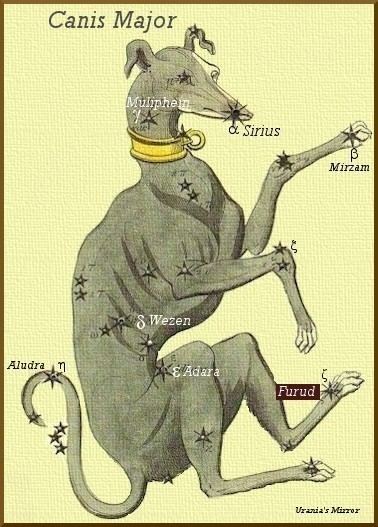Surface temperature 18,700 K Radius 2.714 million km (3.9 R☉) Constellation Canis Major | Mass 1.531 × 10^31 kg (7.7 M☉) Magnitude 3.025 Apparent magnitude (V) 3.025 | |
 | ||
Similar Gamma Canis Majoris, Delta Canis Majoris, Eta Canis Majoris, Beta Canis Majoris, Epsilon Canis Majoris | ||
Zeta Canis Majoris (ζ Canis Majoris, abbreviated Zeta CMa, ζ CMa), also named Furud, is a spectroscopic binary in the constellation of Canis Major.
Zeta Canis Majoris is the star's Bayer designation assigned by the German astronomer Johann Bayer in 1603. The traditional name Furud or Phurud derives from the Arabic ألفرد al-furud meaning 'the bright single ones' or, perhaps by a transcriber's error, from Al Ḳurūd (ألقرد - 'al-qird'), the Apes, or Al Agribah (أل أغربة), the Raven by Al Sufi, referring to the surrounding small stars with some of those of Columba (ζ CMa, Lambda Canis Majoris, Gamma Columbae, Delta Columbae, Theta Columbae, Kappa Columbae, Lambda Columbae, Mu Columbae and Xi Columbae). In 2016, the International Astronomical Union organized a Working Group on Star Names (WGSN) to catalog and standardize proper names for stars. The WGSN's first bulletin of July 2016 included a table of the first two batches of names approved by the WGSN; which included Furud for this star.
This star system has an apparent visual magnitude of +3.0, making it one of the brighter stars in the constellation and hence readily visible to the naked eye. Parallax measurements from the Hipparcos mission yield a distance estimate of around 362 ly (111 pc) from the Sun. This is a single-lined spectroscopic binary system, which means that the pair have not been individually resolved with a telescope, but the gravitational perturbations of an unseen astrometric companion can be discerned by shifts in the spectrum of the primary caused by the Doppler effect. The pair orbit around their common center of mass once every 675 days with an eccentricity of 0.57.
The primary component is a large star with nearly four times the Sun's radius and almost eight times the mass of the Sun. It has a stellar classification of B2.5 V, which means it is a B-type main sequence star that is generating energy through the nuclear fusion of hydrogen at its core. It is emitting 3,603 times the luminosity of the Sun and is a suspected Beta Cephei variable. This energy is being radiated from its outer envelope at an effective temperature of about 18,700 K, giving it the blue-white hue of a B-type star. It is relatively young for a star, with an estimated age of 32 million years.
